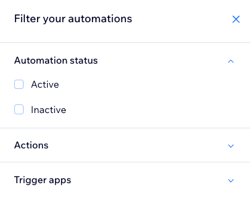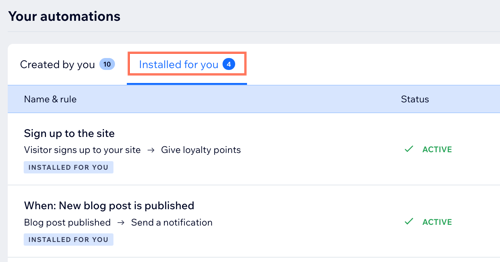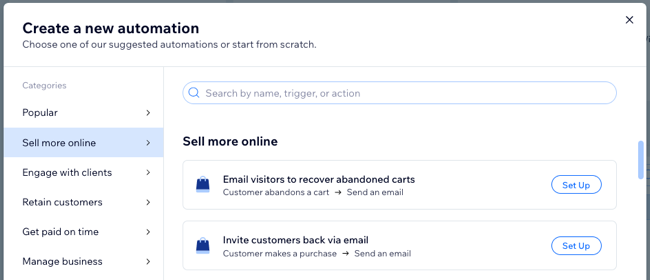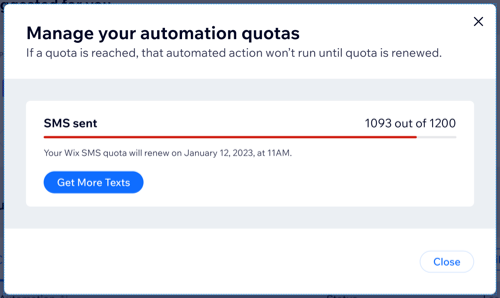
Previous Automation Builder
Wix Automations: Managing Your Automations
This article refers to the previous automation builder. If you're not seeing this version, read our article about the new version of the automation builder.
Automations allow you to streamline your work processes and save time on manual tasks. View and manage all of your automations from the Automations page in your site's dashboard.
Viewing all of your automations
You'll find a full record of all of your active and inactive automations (across all apps) on your Automations page. From here, you can see the number of times your automations have been triggered, edit or duplicate automations, and more.
On your Automations page, you'll see your automations listed in 2 tabs: "Created by you" and "Installed for you".

To view your automations:
Go to Automations in your site's dashboard.
Scroll down to the Your automations section to view all of your automations across 2 tabs:Created by you: Active and inactive automations you've created here or directly through an app.
Installed for you: Active and inactive automations created automatically when you've installed apps.
(Optional) Click an automation to view its automation summary, including the last trigger date and the total times triggered.
Tip:
Click Filters to view only active or inactive automations, or those with specific triggers or actions.

Your "Installed for you" automations
All businesses are unique and benefit from different types of automations. As you build your site, Wix installs automations specific to the apps you add. For example, if you add a Wix Blog to your site, you'll get an automation that notifies members of new blog posts. You can deactivate these at any time.
View and manage your "Installed for you" automations by selecting this tab on your Automations page.

Notes about "Installed for you" automations:
These automations start working as soon as you add the relevant app. Depending on the app, you may be able to deactivate them.
These automations are pre-defined by the app. The logic and configuration can be changed or deleted by the app in the future.
These automations can be edited in the same way as other automations, but you'll only be able to edit certain parts (such as customizing an email design).
Some of these automations will allow you to undo all edits you've made. To do so, hover over the relevant automation and click the More Actions icon
 , then click Reset to default. Resetting to default will reset the automation's email template and statistics.
, then click Reset to default. Resetting to default will reset the automation's email template and statistics.The statistics of an automation will reset if the app owner creates a new version of the automation.
Your recommended automations
In addition to your "Installed for you" automations, you'll see Wix's suggested automations when you start to create a new automation. These are specific to your business type and the apps you've added to your site. They are listed by business benefit to help you choose: "Sell more online", "Engage with clients", and more.
Start the process of creating an automation to view the automations recommended for your site.

Editing, duplicating or renaming an automation
Edit automations so they're working for your business, or rename them so you and your site collaborators can identify them at a glance. Save time by duplicating an existing automation and then making any edits needed. For example, you can use the same email campaign design to respond to different triggers.
To edit, duplicate or rename an automation:
Go to Automations in your site's dashboard.
Scroll down to the Your automations section.
Choose what you want to do:
Edit an automation
Hover over the relevant automation and click the More Actions icon
 .
.Click Edit.
Edit the automation as necessary.
When you're finished editing, click Save.
Learn more about setting up each part of an automation.
Notes:
Editing the timing of an automation can affect "pending" actions. "Pending" actions have been triggered but haven't yet taken place (the timing has been set for them to occur after a certain period of time).
If you edit any part of an automation, the changes only apply to new activations. Automations triggered before the changes were made will still run with the settings previously defined.
Duplicate an automation
Hover over the relevant automation and click the More Actions icon
 .
.Click Duplicate.
Edit the relevant details within your duplicated automation.
Note: Don't forget to update your duplicated automation's name, or it will remain 'Copy of...'.When ready, click Activate.
Rename an automation
Hover over the relevant automation and click the More Actions icon
 .
.Click Rename.
Edit the automation's name.
Click Save.
Deactivating or deleting an automation
Deactivate or delete automations you no longer require. Deactivating an automation will make it inactive, ready to be activated again in future. Deleting an automation will remove it from your page and you won't be able to restore it.
To deactivate or delete an automation:
Go to Automations in your site's dashboard.
Scroll down to the Your automations section.
Hover over the relevant email automation and click the More Actions icon
 .
.Choose what you want to do:
Deactivate an automation
Deactivating an automation will stop it running without deleting it. You can reactivate at any time.
Click the toggle to deactivate an active automation.

Notes:
If you deactivate an automation, any ongoing runs stop and any pending actions are cancelled.
Trigger data isn't collected when an automation is inactive. The automation won't run retroactively when reactivated.
For example, an automation that sends thank you emails following purchases is deactivated on Monday. Joe makes a purchase on Tuesday. The automation is reactivated on Wednesday. Joe won't receive a thank you email because the automation couldn't collect the trigger data on the day of Joe's purchase.
Delete an automation
Click Delete.
Click Delete in the pop-up window to confirm.
Notes:
If you wish to use an automation in the future, consider deactivating it rather than deleting it.
"Installed for you" automations cannot be deleted but can be deactivated.
If you delete an automation, any ongoing runs stop and any pending actions are cancelled.
Viewing your quotas
Some automation actions are subject to quotas. For example, an automation with the action "Send an email" uses emails from your site's email marketing plan. View your quotas from your Automations page so you can easily see when your quotas are running low and you might need to upgrade.

To view your quotas:
Go to Automations in your site's dashboard.
Click Manage Your Quotas.
Viewing your email automation statistics
Automations with "Send email" as the action will give you access to email marketing statistics. You'll be able to see detailed information for each email you're sending, including delivery rate, which links were clicked, and more. You'll also be able to see a list of the recipients who opened the email.

Statistics for all automations:
For all automations, you can view the last triggered date and the total times triggered. Click the relevant automation on your Automations page to display the summary panel.
To view your email automation statistics:
Go to Automations in your site's dashboard.
Scroll down to the Your automations section.
Hover over the relevant email automation and click the More Actions icon
 .
.Click View email stats to view your email marketing statistics.
Note:
Your email statistics are made up of unique recipients. If an email is triggered for the same contact more than once, it counts as only one email.